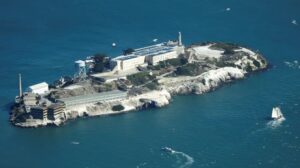Trump orders reopening of Alcatraz prison
In a bold and unexpected announcement, President Donald Trump has revealed plans to reopen the legendary Alcatraz prison in San Francisco Bay to detain the nation’s most notorious criminals. Shared via Truth Social on May 4, 2025, this directive aims to restore law and order by housing violent offenders and immigration detainees in a modernized, expanded version of the iconic island facility. But can this historic site, now a popular National Park Service tourist destination, truly return to its infamous roots? Here’s a deep dive into this provocative proposal.
Restoring Justice: Trump’s Alcatraz Vision
Trump’s order directs the Bureau of Prisons, alongside the Department of Justice, FBI, and Homeland Security, to rebuild and enhance Alcatraz prison. The president underscored the need to address “vicious, repeat offenders” who bring “chaos and suffering” to communities. By reviving Alcatraz, Trump seeks to establish a powerful symbol of law and order, deterring the nation’s most dangerous criminals. He remarked, “In a stronger America, we isolated threats far from society. That’s the way it should be.”
The Rock’s Infamous Past
Dubbed “The Rock”, Alcatraz prison gained its fearsome reputation due to its remote location, surrounded by frigid Pacific waters and treacherous currents that thwarted escape attempts. From 1934 to 1963, it confined notorious figures like Al Capone, George “Machine Gun” Kelly, and Robert Stroud, known as the Birdman of Alcatraz. During its operation, 36 prisoners attempted 14 escapes, with most recaptured or lost to the bay. The 1962 escape by John Anglin, Clarence Anglin, and Frank Morris, immortalized in the film “Escape from Alcatraz”, remains an enduring mystery.
Alcatraz Today: A Tourist Haven
Since closing in 1963, Alcatraz Island has become a National Historic Landmark and one of San Francisco’s premier attractions, welcoming over 1.4 million visitors yearly. Managed by the National Park Service, it offers immersive tours of the cell blocks, historical displays, and stories of events like the 1969–1971 Native American occupation. The prison was shuttered due to exorbitant costs—nearly triple those of other federal facilities—caused by its isolation and deteriorating infrastructure.
Hurdles to Reviving Alcatraz
Reopening Alcatraz as a prison presents formidable challenges. The facility’s aging infrastructure demands significant upgrades to meet modern standards. Professor Gabriel Jack Chin from the University of California Davis School of Law notes that costs could be staggering, given the island’s exposure to corrosive salt air and the need for boat-based supply chains. The National Park Service’s stewardship of the island further complicates matters, requiring congressional approval and substantial funding. With the Bureau of Prisons already managing 16 high-security sites, like the one in Florence, Colorado, skeptics question the plan’s necessity.
Public and Political Firestorm
The proposal has ignited fierce debate. Former House Speaker Nancy Pelosi, representing the district that includes Alcatraz, labeled the idea “frivolous,” emphasizing the island’s role as a national park. San Francisco Democratic State Senator Scott Wiener called it “reckless” and a “disregard for legal norms.” On platforms like X, some applaud the tough-on-crime stance, while others doubt its viability. The Bureau of Prisons has committed to following the order but remains vague on implementation details.
Trump’s Crime and Immigration Agenda
This move aligns with Trump’s broader crackdown on crime and immigration. His attempts to deport alleged gang members to El Salvador’s CECOT prison without due process were struck down by a Texas district judge. By targeting illegal immigrants for Alcatraz, Trump may be seeking to bypass such legal barriers, raising concerns about due process violations. Critics warn this approach risks undermining constitutional protections.
Will Alcatraz Reclaim Its Past?
While Trump’s Alcatraz plan leverages the prison’s daunting legacy to signal strength, its feasibility is uncertain. Skyrocketing costs, logistical nightmares, and resistance from local officials and preservationists pose significant obstacles. As the nation grapples with this audacious idea, one question lingers: Can Alcatraz, a monument to history, be transformed into a modern stronghold for America’s most violent offenders, or will it remain a preserved relic? The answer lies ahead.


